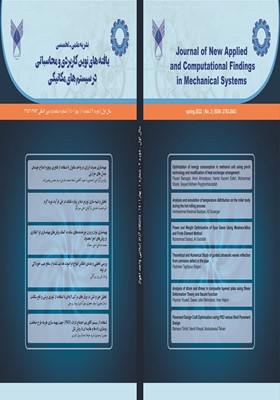بهینهسازی مصرف انرژی در واحد متانول با استفاده از فناوری پینچ و اصلاح چیدمان مبدل های حرارتی
محورهای موضوعی : یافته های نوین کاربردی و محاسباتی در سیستم های مکانیکیپیام برزگر 1 , امین احمدپور 2 , حمید کاظمی اسفه 3 , محمد شارعی 4 , سید محسن پیغمبرزاده 5 *
1 - شرکت ملی صنایع پتروشیمی، شرکت پژوهش و فناوری پتروشیمی
2 - شرکت ملی صنایع پتروشیمی، شرکت پژوهش و فناوری پتروشیمی
3 - گروه مهندسی شیمی، دانشگاه آزاد اسلامی، واحد ماهشهر، ماهشهر، ایران
4 - گروه مهندسی شیمی، دانشگاه آزاد اسلامی، واحد ماهشهر، ماهشهر، ایران
5 - دانشگاه آزاد اسلامی واحد ماهشهر
کلید واژه: نرم افزار ASPEN, بهینه سازی انرژی, واحد متانول, آنالیز پینچ,
چکیده مقاله :
در این بررسی، با استفاده از فناوری پینچ و اصلاح چیدمان مبدلهای حرارتی در یکی از واحد های تولید متانول بهینهسازی مصرف انرژی مورد ارزیابی قرار گرفت. نتایج نشان می دهد که امکان صرفه جویی انرژی با توجه به کل یوتیلیتی مصرفی در شبکه مبدل های فرآیندی به میزان 30.23 درصد وجود دارد. در ادامه، به هدفگذاری روی شبکه مورد بررسی و اصلاح شبکه و آنالیز پینچ با استفاده از نرم افزارهای مختلف پرداخته شد. همچنین سناریوهای مختلفی بر اساس آنالیز پینچ تدوین و به جهت امکان پذیری و قابلیت اجرا مورد تجزیه و تحلیل محاسباتی، فرآیندی و عملیاتی قرار گرفت. در این تحقیق، هفت سناریو جهت چیدمان مبدلها مشخص گردید که امکان حذف یک مبدل پیش گرم کن و تبدیل آن به مبدلی که با استفاده از حرارت سیستم کار کند در سناریوی 1 وجود دارد. سناریو های 2 تا 5 امکان ایجاد صرفه جویی 32 مگاواتی در یوتیلیتی مصرفی را دارند. از طرف دیگر سناریو های 6 و 7 به ترتیب باعث صرفه جویی انرژی 43 و 57 مگاواتی در یوتیلیتی مصرفی می شوند. سناریوی هفتم که بیشترین صرفه جویی انرژی را دارد، می تواند باعث کاهش هزینه های یوتیلیتی تا حدود 11 میلیارد تومان در سال شود. در نهایت سناریو شماره 1 به عنوان بهترین سناریو انتخاب و معرفی گردید. بر اساس سناریوی منتخب، علاوه بر کاهش مصرف بخار، با کاهش توان مصرفی فن های هوایی، مصرف برق واحد نیز کاهش یافت. صرفه حاصل از انجام این سناریو حدودا معادل 5/1 میلیارد تومان در سال محاسبه گردید.
The main goal of this paper is the use of pinch technology and revision in heat exchanger network layout to optimize energy consumption in a methanol unit of a petrochemical company. First of all, the process flow diagrams (PFD) and the current state of the heat exchangers network were studied. Then, the necessary data were analyzed, process heat exchangers and their characteristics were compiled and the physical properties of the streamlines at different temperatures were calculated. Then, the target network was distinguished and the network was modified and pinch analysis was performed using ASPEN HYSYS software and ASPEN ENERGY ANALAYZER software. Finally, different scenarios based on pinch analysis were compiled and feasibility, computational, process and operational analysis was performed. Finally, by calculating energy efficiency in each scenario, only one scenario was selected and introduced as the best scenario. According to the selected scenario, the E-1001exchanger, which uses low pressure steam to heat the incoming feed gas, is transferred to another location in order to not only reduce the steam consumption, but also reduce the unit's power consumption by reducing the air fan load. The profit from this scenario was approximately equal to 1.5 billion tomans per year.
[1] Rao Manohar, P., Energy Conservation and Alternative Sources of Energy in Sugar Factories and Distilleries. )2001(, ISPCK Publishers and Distributors, New Delhi.
[2] Westphalen, D., Maciel, M., (2000). Pinch analysis of evaporation systems. Brazilian Journal of Chemical Engineering 17. pp. 1‐17.
[3] Smith, R., Chemical Process Design and Integration, John Wiley & Sons. 2005: Ltd.
[4] Kralj, A.K., Glavič, P., (2007). Optimization of a gas turbine in the methanol process, using the NLP model. Applied Thermal Engineering 27(11). pp. 1799‐1805.
[5] Greeff, I.L., Visser, J.A., Ptasinski, K.J., Janssenet, F.J.J.G., (2002) Utilisation of reactor heat in methanol synthesis to reduce compressor duty––application of power cycle principles and simulation tools. Applied Thermal Engineering. 22(14). pp. 1549‐1558.
[6] Puerari, F., Bosio, B., Heyen, G. (2014). Energy efficiency optimisation in different plant solutions for methanol production from biomass gasification. Chemical Engineering Transactions 37. pp. 301-306.
[7] Kijevčanin, M. L., Đorđević, B., Ocić, O., Crnomarković, M., Marić, M., &Šerbanović, S. P. (2004). Energy and economy savings in the process of methanol synthesis unsig Pinch technology. Journal of the Serbian Chemical Society 69(10). pp. 827-837.
[8] Jafari Nasr, M.R.N., Abrishami, A. (2012). Energy Management and Process Improvement of Methanol Production. Journal of Petroleum Science and Technology 2(2), pp. 33-39.
[9] Liu, J., Zhang, P., Xie, Q., Liang, D., Bai, L. (2021). Flexibility analysis and design of heat exchanger network for syngas-to-methanol process. International Journal of Coal Science & Technology pp. 1-11.
[10] Philia, J., &Prameswari, J. (2020). Pinch Analysis of Methane Derived Methanol Plant Using HINT Software. In E3S Web of Conferences (Vol. 202, pp. 11004). EDP Sciences.
[11] Liu, J., Zhang, P., Xie, Q., Liang, D., Bai, L., (2021). Flexibility analysis and design of heat exchanger network for syngas-to-methanol process, Int J Coal Sci Technol 8(6). pp.1468–1478.
[12] Nayana, V.T., Gigi, S., (2021), Methanol Synthesis - Dynamic Simulation and Heat Integration, The International Conference on Emerging Trends in Engineering, Yukthi.
[13] Puhar, J., Vujanovic, A., Awad, P., ˇCucˇek, L., (2021). Reduction of Cost, Energy and Emissions of the Formalin Production Process via Methane Steam Reforming. Systems 9, 5.
_||_
